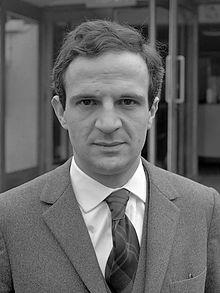François Truffaut (François Roland Truffaut)

After starting his own film club in 1948, François Truffaut met André Bazin, who would have great effect on his professional and personal life. Bazin was a critic and the head of another film society at the time. He became a personal friend of Truffaut’s and helped him out of various financial and criminal situations during his formative years. Truffaut joined the French Army in 1950, aged 18, but spent the next two years trying to escape. François Truffaut was arrested for attempting to desert the army. Bazin used his various political contacts to get Truffaut released and set him up with a job at his newly formed film magazine Cahiers du cinéma. Over the next few years, Truffaut became a critic (and later editor) at Cahiers, where he became notorious for his brutal, unforgiving reviews. He was called “The Gravedigger of French Cinema” and was the only French critic not invited to the Cannes Film Festival in 1958. He supported Bazin in the development of one of the most influential theories of cinema itself, the auteur theory.. In 1954, Truffaut wrote an article in Cahiers du cinéma called “Une Certaine Tendance du Cinéma Français” (“A Certain Trend of French Cinema”), in which he attacked the current state of French films, lambasting certain screenwriters and producers, and listing eight directors he considered incapable of devising the kinds of “vile” and “grotesque” characters and storylines that he declared were characteristic of the mainstream French film industry: Jean Renoir, Robert Bresson, Jean Cocteau, Jacques Becker, Abel Gance, Max Ophuls, Jacques Tati and Roger Leenhardt. The article caused a storm of controversy, and also landed Truffaut an offer to write for the nationally circulated, more widely read cultural weekly Arts-Lettres-Spectacles. Truffaut would pen more than 500 film articles for that publication over the next four years. Truffaut later devised the auteur theory, which stated that the director was the “author” of his work; that great directors such as Renoir or Hitchcock have distinct styles and themes that permeate all of their films. Although his theory was not widely accepted then, it gained some support in the 1960s from American critic Andrew Sarris. In 1967, François Truffaut published his book-length interview of Hitchcock, Hitchcock/Truffaut (New York: Simon and Schuster).
After having been a critic, François Truffaut decided to make films of his own. He started out with the short film Une Visite in 1955 and followed that up with Les Mistons in 1957. After seeing Orson Welles’ Touch of Evil at the Expo 58, he was inspired to make his feature film debut in 1959 with Les Quatre Cents Coups (The 400 Blows). This film was an instant success and won him a prize at the Cannes Film Festival. This film and the following films were successful even with the low budget he had to make the films. He also acted, appearing in Steven Spielberg’s 1977 film Close Encounters of the Third Kind, where he played scientist Claude Lacombe. In July 1983, Truffaut rented France Gall and Michel Berger’s house outside Honfleur, Normandy (composing for Philippe Labro’s film, Rive droite, rive gauche) when he had a first stroke and was diagnosed with a brain tumor. He was expected to attend his friend Miloš Forman’s Amadeus premiere when he died on 21 October 1984, aged 52, at the American Hospital in Neuilly-sur-Seine in France. At the time of his death, he still had numerous films in preparation. His goal was to make 30 films and then retire to write books for his remaining days. He was five films short of his personal goal. He is buried in Paris’ Montmartre Cemetery.
Born
- February, 06, 1932
- Paris, France
Died
- October, 21, 1984
- Neuilly-sur-Seine, Hauts-de-Seine, France
Cause of Death
- brain tumor
Cemetery
- Cimetiere de Montmartre
- Paris, France



